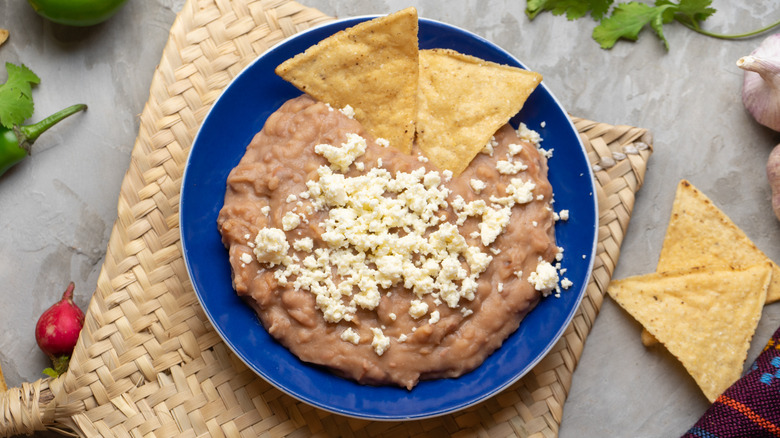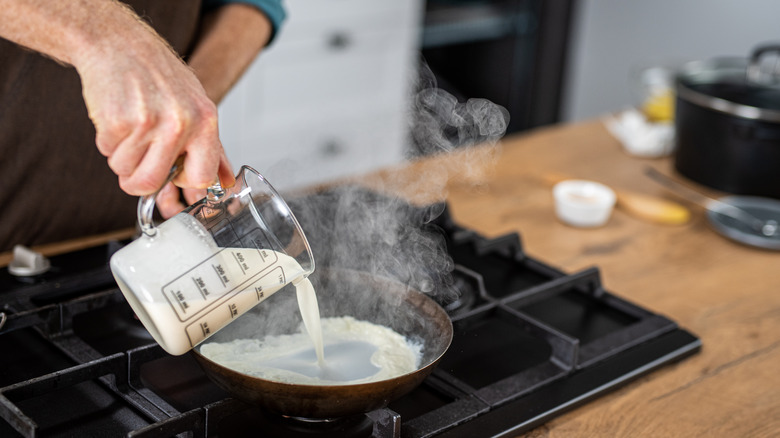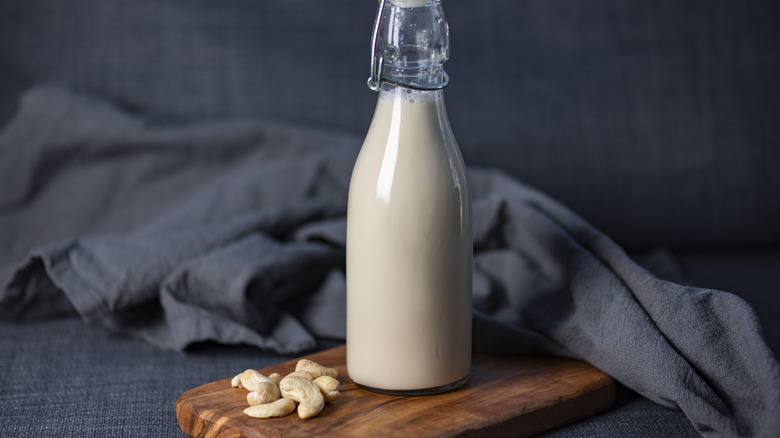Should You Add Milk Or Water To Refried Beans? It Makes A Difference
The common bean got its start in agriculture about 8,000 years ago in central Mexico, and beans remain a key ingredient in many food cultures around the world today. The pinto is still the most popular in the United States, and plenty of traditional Mexican recipes rely on it as well. Among these, refried beans are broadly beloved, but the best preparation is just as widely debated.
The list of ingredients for refried beans is simple: beans, some kind of liquid or fat (or both), an allium or two, and salt. Some cooks also like to add a bit of spice, such as chiles, chili powder, or epazote (an indigenous Mexican herb often likened to oregano). Generally, you cook the beans in water, then strain them and add them to your aromatics, with fat, to keep cooking while you mash them. If they get too dry at this stage, the standard practice is to add water.
There are strong opinions about pinto versus black beans and garlic versus onion, but one of the most divisive ingredients is the liquid used in this final step. And rightly so: Next to the fat, this is the ingredient that has the greatest impact on the essential creaminess that sets a recipe apart from the rest. While strained water reserved from the cooking stage is better than plain, milk lends an altogether richer flavor and texture that make for a perfect plate of refried beans.
The advantages of cooking refried beans with milk
The defining characteristic of refried beans is their smooth texture, which is partially achieved by mashing the beans after they've first been cooked. Many cooks add a form of fat during this step: Lard is one of the more traditional ingredients, but olive or vegetable oil is often used as well, and cookbook author Zarela Martinez advocates for butter (via Serious Eats).
As for the liquid used to keep the beans moist at this stage? While some of the water used to boil the beans can be reserved and used as an easy, affordable, and vegan option, dairy products like milk are ideal when you're looking to create a rich, velvety consistency and add depth of flavor. The natural fat content (especially in whole milk) contributes to the perception of creaminess, according to research in Chemical Senses. Adding a fatty liquid for moisture in addition to the fat used for cooking can take this dish's famous creamy goodness to the next level.
Look for milk from grass-fed cows if you can find it, as some studies (via Foods) show that it can have higher milk fat content. In addition to a silky texture, fat is also associated with an enhanced capacity to bolster flavors, like spices. To buoy the contributions of signature additives to refried beans (like onions and peppers) and achieve a smoother, more complex taste, using milk as the liquid in your recipe makes all the difference.
Vegan and nut-free alternatives for creamy refried beans
If you want to prepare thick, smooth, and satisfying refried beans without using dairy products, there are plenty of dairy-free and vegan replacements for cow's milk. Most nut milk contains some amount of fat as well; not nearly as much as dairy, but certainly more than water. Coconut and cashew milk are considered some of the creamiest milk alternatives, while almond milk is often more widely available.
For those with nut allergies, rice milk is a great option, since rice and beans are such a perfect pair — but if you want to truly celebrate the versatility of beans throughout your entire dish, you can add soy milk instead. Also, keep in mind that each of these alternative milks has its own unique flavors that might influence the final taste. If you're not sold on one option, the recipe is easy enough to experiment with again and again, so next time you're craving refried beans, add whatever milk you have on hand and see what you think!



